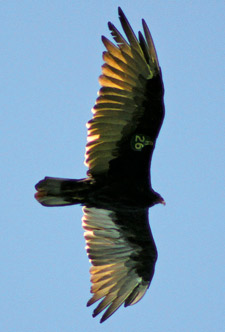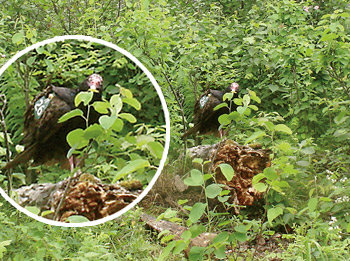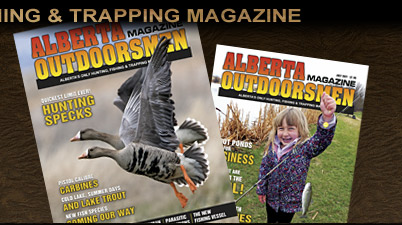|
 |
Back in 2003, a team of birders, led by now 86-year-old naturalist Stuart Houston, began trapping, tagging and tracking turkey vulture nestlings in Saskatchewan, wherever a nest was reported. These reports came mostly from old abandoned farmhouses or dilapidated buildings that sit with frequency on the prairie landscape.
Houston and his team soon collaborated with Hawk Mountain Sanctuary in Kempton, Pennsylvania. Hawk Mountain Sanctuary is an association dedicated to the research and conservation of birds of prey and as such, they began the Turkey Vulture Migration Project, “a long-term study of migration behaviour in Turkey Vultures in an effort to learn more about the extent, causes, and consequences of their annual journeys.”
Turkey vultures normally nest in caves or in large brush piles; however, in the last 25-30 years they have learned to nest in the attics or basements of deserted farmhouses, allowing them to expand their territory and population.
 |
| Colin Bamsey of Edgerton, Alberta took this photo of H26 near Kehewin Lake in August of 2013. |
Once captured by Houston and his team, the nestlings are fitted with a green wing-tag containing white alpha-numeric’s identifying the vulture. Some are given GPS satellite transmitters that provide hourly reports as to the bird’s whereabouts, within 10 metres.
Turkey vultures cannot be banded like other birds, as they have a nasty habit of defecating down their legs, which helps to keep them cool. This nasty habit, when combined with a birder’s band, can cause serious problems to the vulture, as their body waste builds up on the band and creates an un-removable cement-like mass.
Turkey vultures are considered partial migrants, meaning “northern populations of the species migrate, whereas southern populations, in general, do not.”
From their wing-tags and transmitters, Stuart and his team have found Saskatchewan turkey vultures wintering as far away as Costa Rica and Venezuela.Most vultures from Canada arrive in these southern regions in late November or early December.
In August of 2008, near Baptiste Lake in Athabasca County, I positioned one of my trail cameras at a spot near where a deer had perished. I’m not sure how the mostly-consumed deer had died, but I figured it would be a good opportunity to get a photo of some coyotes or a bear, maybe even a wolf or two. I never in my wildest dreams would have guessed that a photo of a turkey vulture was even remotely possible, especially this far north. To me, turkey vultures were a southern prairie bird, certainly not something inhabiting Alberta’s northern boreal forest.
But sure enough, get a photo of a turkey vulture I did, wearing a wing-tag with the marking H26 on it. In short order, I was put in touch with Stuart Houston, who informed me that my bird was four-years-old and had been wing-tagged near Ranger, Saskatchewan as a nestling on August 5, 2004. As far as I still know, my sighting of H26 is the farthest northwest sighting ever of a turkey vulture.
 |
| Rob Miskosky took this photo of H26 near Baptiste Lake, Alberta in August 2008. H26 was 4-years-old at the time. |
According to Houston, H26’s sibling, H25, was given a GPS transmitter at the same time H26 was wing-tagged. Unfortunately, H25 perished somewhere near Lincoln, Nebraska after one season wintering in Costa Rica.
Since my trail camera took that photograph, H26 has remained just an interesting story; one that I could share with friends. And sometimes I wondered how H26 was doing. After all, how many people can claim to have photographed a turkey vulture with a wing-tag? But then, as so often happens with time, I forgot about H26 altogether.
That was until Stuart Houston alerted me in early October 2013 to another sighting of H26, who was now nine-years-old.
Retired professional forester, Colin Bamsey, had managed a photo of H26 at Kehewin Lake, near St. Paul, Alberta. According to Bamsey, “On August 20, 2013, I was out on my tree house deck looking for a photo of the raven family that had nested nearby in an old osprey nest, when a turkey vulture flew right overhead, about 10 metres above the treetops. It wasn’t until I transferred the photos to my laptop that I noticed the vulture had a tag clipped to its wing that read H26.”
While Stuart Houston continues his work in Saskatchewan, Wayne Nelson has taken up the task in Alberta. Wayne uses yellow wing-tags with black alpha-numeric’s on his Alberta turkey vultures.
So, if you see a large black bird wearing a wing-tag, be assured, it is most likely a turkey vulture with an interesting story to tell. ■
For previous Outdoor Pursuits click here.
|
|
|
|


